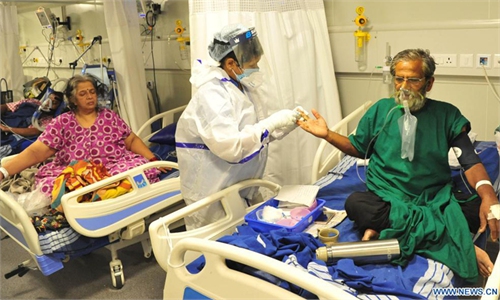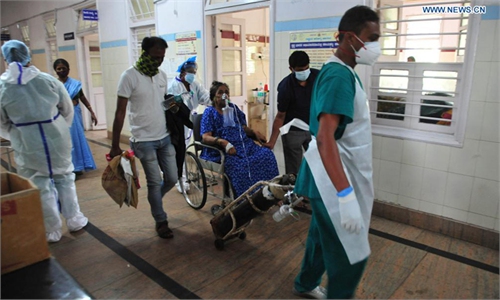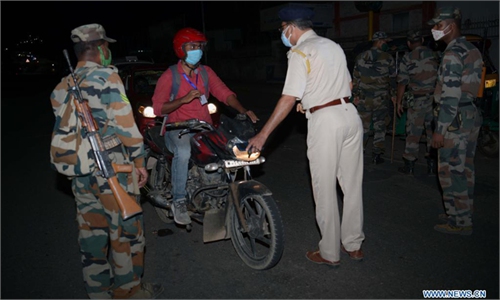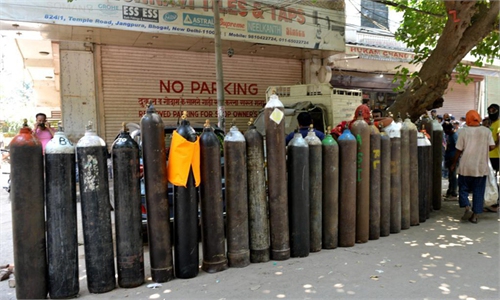Weakened by fever and gasping for breath, 47-year-old Vinod Kumar died in an ambulance more than 60 kilometers from his home in India's eastern Bihar state, far from the big cities at the center of the nation's devastating COVID-19 crisis.
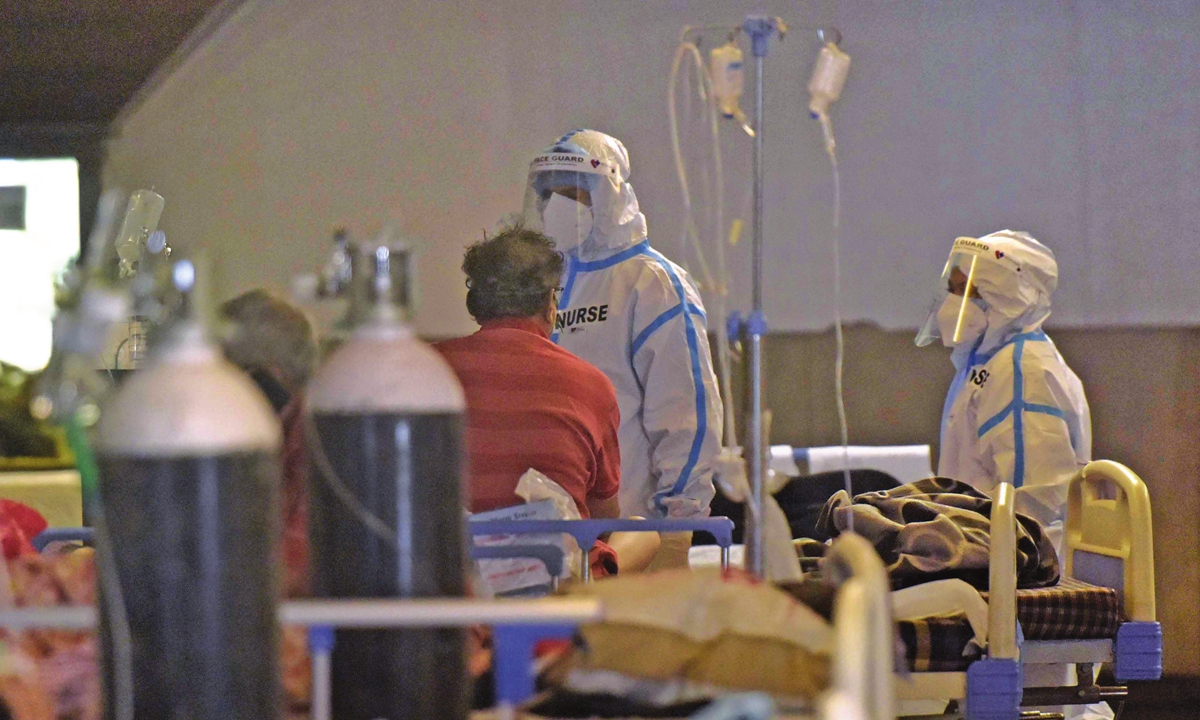
"We admitted him wherever we found a bed. It was a nursing home but wasn't functioning like one. Patients were getting their own oxygen," said Kameshwar Kumar, Vinod's brother.
"The hospital was rationing its oxygen supply to patients and my brother was sinking so we were forced to rush him to another hospital but he didn't make it," Kumar told Reuters by phone, crying as he spoke.
India's COVID-19 crisis has been most acute in the capital, New Delhi, among other cities, but in rural areas - home to nearly 70 percent of India's 1.3 billion people - limited public healthcare is posing particular challenges.
Ill-equipped hospitals, staff shortages, and long journeys to dedicated COVID-19 wards are making it harder for village patients to access treatment as a second wave pushed India's total coronavirus disease cases to more than 20 million this week.
Less extensive testing and public awareness about the disease's symptoms - especially in the countryside - mean the actual number of infections could be five to 10 times higher than reported, medical experts say.
"The situation has become dangerous in villages," said Suresh Kumar, a field coordinator with Manav Sansadhan Evam Mahila Vikas Sansthan, a human rights charity.
In some villages where the charity works in the northern state of Uttar Pradesh - home to about 200 million people - "there are deaths in almost every second house," he said.
"People are scared and huddled in their homes with fever and cough. The symptoms are all of COVID-19, but with no information available many think it is seasonal flu."
India's health ministry did not respond to a request for comment.
Quacks, concoctions
In the village of Kodai, which lies in Prime Minister Narendra Modi's Varanasi constituency, emergency facilities set up during 2020's first wave of coronavirus disease infections were dismantled earlier in 2021 when cases dropped.
"The quarantine centers set up for returning migrant workers were closed and so are the fever camps," Vijay Kumar, a village resident, said by phone.
"Returning migrant workers are going home, falling sick and there is no one keeping track. People are drinking home concoctions and depending on quacks for treatment. Most of them are dying in the process."
Elsewhere, local activists warned that pre-monsoon agricultural activities mean more farmworkers are on the move - increasing the risk of contagion in rural districts.
In Bihar's Bikram district, about 200,000 residents of 15 villages have one primary healthcare center (PHC) equipped for COVID-19 care, with a stock of 12 oxygen cylinders and one ambulance.
As cases multiply from one week to the next, such stocks are woefully inadequate, officials said.
"We have asked for 30 more oxygen cylinders as our stock may fall short," said Om Prakash Kumar, the monitoring and evaluation officer for Bikram, where 150 coronavirus disease cases were registered over the past 15 days.
In Patna, Bihar's capital, nearly 40 of 100 test samples are testing positive and local hospitals are overrun.
"I get calls for beds every day. But where are the beds? Our in-charge of a primary healthcare center died last night in a private nursing home as we couldn't find him a bed in a proper hospital," said Krishnakant Singh, who oversees two PHCs in Patna district.
"Just oxygen won't help. We need intensive care units [ICUs] and ventilators. Just breathing has become difficult here," he said.
PHCs are not equipped to handle serious cases requiring hospitalization, said public health expert Abhay Bang.
"Access to healthcare has increased in the past couple of decades with more health centers, better access to government hospitals, and expansion of private hospitals everywhere... but the issues of quality, cost, and ethics remain," he said.
'I lost him'
In Bhadoi district, pharmacist Sagar Sharma has been racing from village to village in recent weeks to distribute anti-fever medication to people who have fallen sick with COVID-19.
"I do what I can. When I see patients who can't breathe or in severe distress, I tell them to go to a hospital," said Sharma, who locals have nicknamed the jholawala doctor (doctor with a bag).
He said, however, that many local doctors were refusing to do home visits for COVID-19 patients even though the nearest hospital was located 20 kilometers away.
In western Maharashtra state, Laxmi More had no choice but to take her seriously ill husband to a private hospital with an ICU in Pandharpur, which lies some 55 km from her village.
He died on April 25 in the ICU, which had a capacity for 10 patients but was treating 20 at the time, she said.
"I lost him and the hospital gave me a bill of 500,000 rupees [$6,772]," said More, whose husband, aged 46, worked as a driver.
"I'm taking loans from family and local lenders to repay. How am I to raise this kind of money?" she said.

Health workers in PPE check a COVID-19 patient to an isolation ward at the temporary COVID-19 Care facility center attached to LNJP Hospital, at Shehnai Banquet in New Delhi, India, on April 29. Photo: VCG
His death last week followed a frantic journey and dozens of phone calls by desperate relatives in search of a hospital bed and oxygen supplies, as a nationwide surge in coronavirus disease cases exposes the limitations of health facilities in the countryside."We admitted him wherever we found a bed. It was a nursing home but wasn't functioning like one. Patients were getting their own oxygen," said Kameshwar Kumar, Vinod's brother.
"The hospital was rationing its oxygen supply to patients and my brother was sinking so we were forced to rush him to another hospital but he didn't make it," Kumar told Reuters by phone, crying as he spoke.
India's COVID-19 crisis has been most acute in the capital, New Delhi, among other cities, but in rural areas - home to nearly 70 percent of India's 1.3 billion people - limited public healthcare is posing particular challenges.
Ill-equipped hospitals, staff shortages, and long journeys to dedicated COVID-19 wards are making it harder for village patients to access treatment as a second wave pushed India's total coronavirus disease cases to more than 20 million this week.
Less extensive testing and public awareness about the disease's symptoms - especially in the countryside - mean the actual number of infections could be five to 10 times higher than reported, medical experts say.
"The situation has become dangerous in villages," said Suresh Kumar, a field coordinator with Manav Sansadhan Evam Mahila Vikas Sansthan, a human rights charity.
In some villages where the charity works in the northern state of Uttar Pradesh - home to about 200 million people - "there are deaths in almost every second house," he said.
"People are scared and huddled in their homes with fever and cough. The symptoms are all of COVID-19, but with no information available many think it is seasonal flu."
India's health ministry did not respond to a request for comment.
Quacks, concoctions
In the village of Kodai, which lies in Prime Minister Narendra Modi's Varanasi constituency, emergency facilities set up during 2020's first wave of coronavirus disease infections were dismantled earlier in 2021 when cases dropped.
"The quarantine centers set up for returning migrant workers were closed and so are the fever camps," Vijay Kumar, a village resident, said by phone.
"Returning migrant workers are going home, falling sick and there is no one keeping track. People are drinking home concoctions and depending on quacks for treatment. Most of them are dying in the process."
Elsewhere, local activists warned that pre-monsoon agricultural activities mean more farmworkers are on the move - increasing the risk of contagion in rural districts.
In Bihar's Bikram district, about 200,000 residents of 15 villages have one primary healthcare center (PHC) equipped for COVID-19 care, with a stock of 12 oxygen cylinders and one ambulance.
As cases multiply from one week to the next, such stocks are woefully inadequate, officials said.
"We have asked for 30 more oxygen cylinders as our stock may fall short," said Om Prakash Kumar, the monitoring and evaluation officer for Bikram, where 150 coronavirus disease cases were registered over the past 15 days.
In Patna, Bihar's capital, nearly 40 of 100 test samples are testing positive and local hospitals are overrun.
"I get calls for beds every day. But where are the beds? Our in-charge of a primary healthcare center died last night in a private nursing home as we couldn't find him a bed in a proper hospital," said Krishnakant Singh, who oversees two PHCs in Patna district.
"Just oxygen won't help. We need intensive care units [ICUs] and ventilators. Just breathing has become difficult here," he said.
PHCs are not equipped to handle serious cases requiring hospitalization, said public health expert Abhay Bang.
"Access to healthcare has increased in the past couple of decades with more health centers, better access to government hospitals, and expansion of private hospitals everywhere... but the issues of quality, cost, and ethics remain," he said.
'I lost him'
In Bhadoi district, pharmacist Sagar Sharma has been racing from village to village in recent weeks to distribute anti-fever medication to people who have fallen sick with COVID-19.
"I do what I can. When I see patients who can't breathe or in severe distress, I tell them to go to a hospital," said Sharma, who locals have nicknamed the jholawala doctor (doctor with a bag).
He said, however, that many local doctors were refusing to do home visits for COVID-19 patients even though the nearest hospital was located 20 kilometers away.
In western Maharashtra state, Laxmi More had no choice but to take her seriously ill husband to a private hospital with an ICU in Pandharpur, which lies some 55 km from her village.
He died on April 25 in the ICU, which had a capacity for 10 patients but was treating 20 at the time, she said.
"I lost him and the hospital gave me a bill of 500,000 rupees [$6,772]," said More, whose husband, aged 46, worked as a driver.
"I'm taking loans from family and local lenders to repay. How am I to raise this kind of money?" she said.
